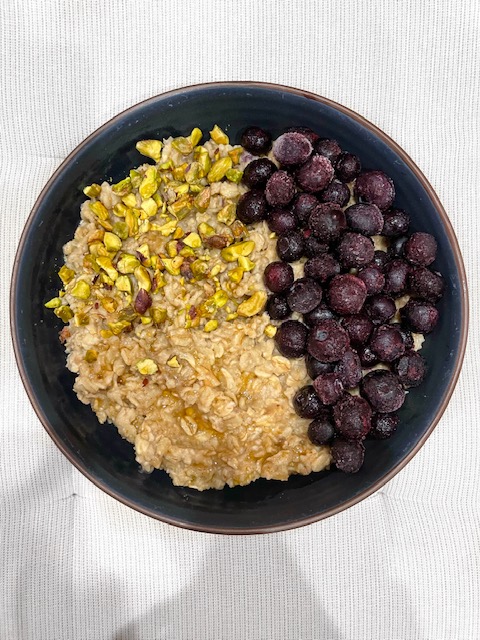Recipes for Managing Side Effects Series: Smell Aversion
Eating during cancer treatment can be difficult, especially if you are experiencing common side effects such as smell aversion. Smell aversions may be caused by chemotherapy and some targeted therapies, certain medications, or a sudden change in taste receptors on your tongue [i]. This may cause a decrease in appetite and unintentional weight loss. Because of this, it is important to consume a sufficient amount of calories during treatment by finding foods that work for you.
Quick Tips to Manage Smell Aversions
- Be adventurous and try new foods when you are feeling positive. This might help avoid developing a smell aversion when you are having a bad day.
- If you are experiencing metallic taste or smell, try consuming your meals in plastic or glass serving dishes and using plastic utensils.
- If possible, ask your caretaker to cook for you or consume ready to eat meals.
- Modify and trial various textures, temperatures, flavors and presentation of food.
- If sweet foods smell or taste too sweet, try salty, bitter or sour foods.
- If foods smell or taste too salty, bitter or sour, add honey, maple syrup, or fruit to calm harsh flavors.
- Cover beverages with a lid and drink through a straw to minimize smell.
- Emphasize presentation as it may encourage a positive meal experience. [i, ii, iii]
Nutritional Content and Health Benefits
Oats are a great addition to any diet, but especially during cancer treatment. Oats are high in fiber and a number of vitamins and minerals including thiamine, magnesium, zinc and phosphorus [iv]. Beta-glucan is the main soluble fiber in oats. Beta-glucan has been linked to heart health, insulin control, and digestive health including prevention of constipation and bowel regularity [v, vi, vii]. One cup of cooked old fashioned oats provides 150 calories, 5 grams of protein, 27 grams of carbohydrate, 3 grams of fat and 4 grams of fiber [viii]. This is a great option if you are struggling with smell aversions or dysgeusia (alteration of taste) as oatmeal alone is bland with a minimal smell.
Blueberries contain a fair amount of phytochemicals that protect the body in a multitude of ways. Phytochemicals may benefit human health and are found in plants. Benefits can range from improving brain function to preventing heart disease and other chronic diseases [ix, x]. With their high antioxidant properties, blueberries are a great addition to any meal or snack. Blueberries have a mild, sweet smell, making them a great option for smell aversions.
Recipe
Oatmeal Breakfast Bowl
Serves: 1

Ingredients
- 1 cup milk or non-dairy milk
- ½ cup frozen or fresh blueberries
- ½ cup old fashioned oats
- ½ teaspoon vanilla extract
- 1 teaspoon cinnamon
- Pinch of salt
Optional Toppings
- 2 teaspoons honey drizzle
- 1 oz pistachios
- 1/2 sliced banana
- 1 Tablespoon Greek yogurt
Instructions
- In a small pot, boil milk or non-dairy milk over medium high heat. Note: dairy milk has a stronger smell, so you may want to choose non-dairy if you do not tolerate the smell well.
- When milk begins bubbling, incorporate berries, oats, vanilla extract, cinnamon and a pinch of salt. Stir to combine and bring mixture to a boil. Note: it is optional to heat the berries with your oats. If you prefer them cold, add them as a topping at the end as shown.
- Once mixture is at a rolling boil, lower heat to a medium-low flame and cover with a tight fitting lid. Cook for about 5-7 minutes, stirring occasionally, until oats have absorbed most of the milk.
- Remove from heat, remove lid and let stand for 3-4 minutes.
- Pour oatmeal into a glass or plastic bowl and top with optional toppings as desired!
References:
[i] Taste and Smell Changes. Accessed July 6, 2021. https://www.cancer.org/treatment/treatments-and-side-effects/physical-side-effects/eating-problems/taste-smell-changes.html
[ii] Taste and Smell Changes: A Side Effect of Treatment. Breastcancer.org. Published July 29, 2020. Accessed July 6, 2021. https://www.breastcancer.org/treatment/side_effects/taste_smell_change
[iii] Tips to make food tastier during cancer treatment. Mayo Clinic. Accessed July 6, 2021. https://www.mayoclinic.org/diseases-conditions/cancer/in-depth/cancer/art-20047536
[iv] Rasane P, Jha A, Sabikhi L, Kumar A, Unnikrishnan VS. Nutritional advantages of oats and opportunities for its processing as value added foods – a review. J Food Sci Technol. 2015;52(2):662-675. doi:10.1007/s13197-013-1072-1
[v] Ciecierska A, Drywień ME, Hamulka J, Sadkowski T. Nutraceutical functions of beta-glucans in human nutrition. Rocz Panstw Zakl Hig. 2019;70(4):315-324. doi:10.32394/rpzh.2019.0082
[vi] Chan GC-F, Chan WK, Sze DM-Y. The effects of β-glucan on human immune and cancer cells. J Hematol Oncol. 2009;2:25. doi:10.1186/1756-8722-2-25
[vii] Murphy EA, Davis JM, Carmichael MD. Immune modulating effects of β-glucan. Curr Opin Clin Nutr Metab Care. 2010;13(6):656-661. doi:10.1097/MCO.0b013e32833f1afb
[viii] FoodData Central. Accessed July 6, 2021. https://fdc.nal.usda.gov/fdc-app.html#/food-details/557209/nutrients
[ix] Ma L, Sun Z, Zeng Y, Luo M, Yang J. Molecular Mechanism and Health Role of Functional Ingredients in Blueberry for Chronic Disease in Human Beings. Int J Mol Sci. 2018;19(9):2785. doi:10.3390/ijms19092785
[x] Kalt W, Cassidy A, Howard LR, et al. Recent Research on the Health Benefits of Blueberries and Their Anthocyanins. Adv Nutr. 2020;11(2):224-236. doi:10.1093/advances/nmz065
